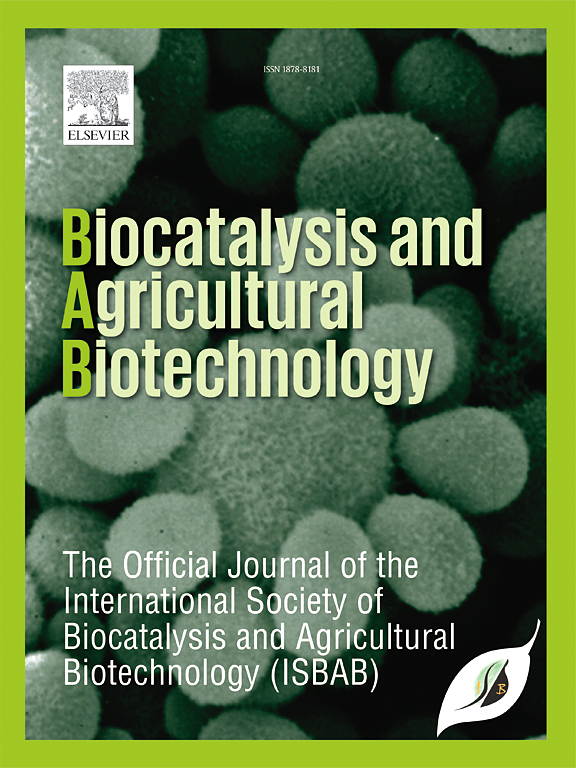通过体外和硅学分析研究十五烷酸介导的抗菌群感应对金黄色葡萄球菌感染的疗效
IF 3.4
Q2 BIOTECHNOLOGY & APPLIED MICROBIOLOGY
引用次数: 0
摘要
耐甲氧西林金黄色葡萄球菌(MRSA)是一种重要的人类病原体,因其倾向于产生生物膜而被公认,生物膜在抗生素耐药性的产生和慢性感染中起着重要作用。由于法定量感应(QS)系统和生物膜的形成对金黄色葡萄球菌的致病性至关重要,因此它们是治疗干预的重要目标。在 Hydnocarpus wightianus 种子提取物中发现了十五烷酸(PA)。它是一种奇链饱和脂肪酸,对心血管、免疫和肝功能有诸多益处。在所有测试浓度下,它都没有细胞毒性,具有剂量依赖性、广泛的抗炎和抗增生特性。PA 具有浓度依赖性抗菌作用,其亚抑制剂量可显著减少所有金黄色葡萄球菌菌株的生物膜形成。此外,PA 还大大降低了细胞外聚合物质(EPS)的形成、蛋白酶活性、微生物粘附性和运动性,证明其具有降低细菌致病性的能力。显微镜检查显示,经 PA 处理的细胞减少了生物膜的形成。在 PA 的作用下,金黄色葡萄球菌菌株产生的毒力因子短链霉素大幅减少。通过分子对接实验发现,PA 与与生物膜和 QS 相关的重要靶蛋白,如胶原粘附蛋白(cna;PDB ID-1AMX)、AgrA(PDB ID-4G4K)、AgrC(PDB ID-4BXI)、SarA(PDB ID-2FNP)和脱氢葵醛合成酶(CrTM;PDB ID-2ZCO)有很强的结合亲和力。分子动力学模拟进一步验证了 PA 与金黄色葡萄球菌蛋白复合物的稳定性。PA 有可能成为一种有效的抗金葡菌感染的抗病毒药物,为替代疗法提供了一条可能的途径。本文章由计算机程序翻译,如有差异,请以英文原文为准。

Anti-quorum sensing mediated anti-infective efficacy of pentadecanoic acid against Staphylococcus aureus infections through in vitro, and in silico analyses
Methicillin-resistant Staphylococcus aureus (MRSA) is a significant human pathogen that is recognized for its tendency to produce biofilms, which plays a role in the development of antibiotic resistance and chronic infections. Since quorum sensing (QS) systems and biofilm formation are essential to S. aureus pathogenicity, they are significant targets for therapeutic intervention. Pentadecanoic acid (PA) was identified in Hydnocarpus wightianus seed extract. It's odd-chain saturated fatty acid with numerous benefits for cardiovascular, immunological, and liver function. It was found to be non-cytotoxic at all concentrations tested, with dose-dependent, broad anti-inflammatory and antiproliferative properties. PA showed concentration-dependent antibacterial action and its sub-inhibitory doses significantly decreased biofilm formation in all S. aureus strains. In addition, PA substantially lowered the formation of extracellular polymeric substance (EPS), protease activity, microbial adhesion, and motility, demonstrating its capacity to reduce bacterial pathogenicity. Microscopic examination revealed that the PA-treated cells had reduced biofilm development. The production of the virulence factor staphyloxanthin by S. aureus strains were substantially reduced in the presence of PA. Strong binding affinities of PA were found by molecular docking experiments to important target proteins associated with biofilm and QS, such as collagen adhesin (cna; PDB ID-1AMX), AgrA (PDB ID-4G4K), AgrC (PDB ID-4BXI), SarA (PDB ID-2FNP), and dehydrosqualene synthase (CrTM; PDB ID-2ZCO). The stability of PA with the S. aureus protein complex was further validated by molecular dynamics simulations. PA has the potential to be an efficient anti-virulence drug against S. aureus infections, providing a possible route for alternative therapies.
求助全文
通过发布文献求助,成功后即可免费获取论文全文。
去求助
来源期刊

Biocatalysis and agricultural biotechnology
Agricultural and Biological Sciences-Agronomy and Crop Science
CiteScore
7.70
自引率
2.50%
发文量
308
审稿时长
48 days
期刊介绍:
Biocatalysis and Agricultural Biotechnology is the official journal of the International Society of Biocatalysis and Agricultural Biotechnology (ISBAB). The journal publishes high quality articles especially in the science and technology of biocatalysis, bioprocesses, agricultural biotechnology, biomedical biotechnology, and, if appropriate, from other related areas of biotechnology. The journal will publish peer-reviewed basic and applied research papers, authoritative reviews, and feature articles. The scope of the journal encompasses the research, industrial, and commercial aspects of biotechnology, including the areas of: biocatalysis; bioprocesses; food and agriculture; genetic engineering; molecular biology; healthcare and pharmaceuticals; biofuels; genomics; nanotechnology; environment and biodiversity; and bioremediation.
 求助内容:
求助内容: 应助结果提醒方式:
应助结果提醒方式:


